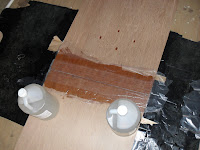
Then I stiched my pieces together with my zip ties
So all in all I found that if I used a zip tie to connect the transom to one side and then leaned the whole thing against the table while I pushed the other side out, I could swing the transome in and thread another tie through the other side. It was touch and go while I tried to get some of the frames in, the weight of the sides never reall held them in place, so I used some small screws to hold them in place.
The frames are not quite in the right place, but I think if I get the third frame in and get another set of hands, I can start to put in the longitudinal frames and dagger board trunk next.
There are a few materials I need to get first, like a stack of 1x1/2 in pine cleats to stiffen some of the longidudinal frames. It will be interesting if nothing else.
At least now it looks (kind of) like a boat even if it's upside down.





















